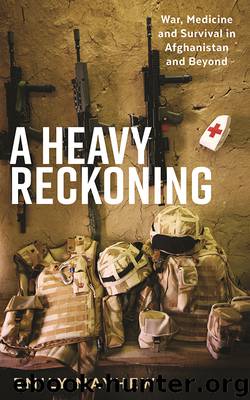A Heavy Reckoning by Emily Mayhew

Author:Emily Mayhew
Language: eng
Format: epub
Publisher: Profile Books
And it is a dynamic ladder: pain is assessed in relation to what has gone before. (How is pain now? Is it better than before or worse that before?) Patients can travel up and down the ladder as their pain gets worse or better, and it is much easier for everyone if pain can be described comparatively along the way. Quickly the pain team discovered that, although the WHO ladder was the right system for them, it wasn’t quite long enough, so at Birmingham it had a fourth step: severe, uncontrolled pain.
So, as they hoped it had at point of wounding, pain treatment at Birmingham began with a clear question that the military pain team’s patients could answer because it was about their own pain and its history, and that was less of a hard question because they designed it to be easier. From that they built individualised, multi-modal treatment. Another fundamental principle. For the kind of pain that requires a fourth step on the ladder nothing is ever going to work on its own. Mild drugs, not opioids, starting with paracetamol and ibuprofen. Nerve blocks and lots of epidurals. Drugs to treat anxiety about future pain and futures in general. If the pain ‘is not amenable to a regional technique’, use drugs to treat pain at the nerve site. A double hit is best: opioids that treat pain at the place of pain and where it registers in the brain, modified release or immediate effect, as strong as necessary, even if that meant the hallucinations came back. Hallucinations are better than pain: intense and unpleasant but better than pain.19 Whatever the maximum dosage for all the medications was, you can be sure the pain team used it for their patients who found themselves trapped and terrified on step four of the pain ladder until they came back down.
Eventually, most of them did come down, one step at a time, sometimes backwards then forwards again, and mostly never quite off the ladder, staying on the first step – mild pain, but better than yesterday. It was pain treatment as conversation, where each listened carefully to the questions of the other because they understood the language being used and it was a good place to start; but also, the pain team hoped, it gave their patients some sense of control or at least participation in their own treatment, because the pain team knew they would need it. Pain would follow them out of Birmingham, into rehab and everything would be easier if they understood their pain, and could express it clearly.
Other conversations too, other hard questions, such as why could a patient feel a limb that was clearly no longer there. It was nurses from the pain team who answered that what they were feeling was called a phantom limb, and it was quite normal that they should feel it because phantom limbs have been known about for centuries. Almost everyone who has an amputation, for whatever reason, gets them. Phantom
Download
This site does not store any files on its server. We only index and link to content provided by other sites. Please contact the content providers to delete copyright contents if any and email us, we'll remove relevant links or contents immediately.
Becoming by Michelle Obama(9981)
Beartown by Fredrik Backman(5683)
The Last Black Unicorn by Tiffany Haddish(5607)
Man's Search for Meaning by Viktor Frankl(4510)
The Book of Joy by Dalai Lama(3947)
The Five People You Meet in Heaven by Mitch Albom(3524)
In a Sunburned Country by Bill Bryson(3509)
The Choice by Edith Eva Eger(3441)
Full Circle by Michael Palin(3419)
The Mamba Mentality by Kobe Bryant(3228)
The Social Psychology of Inequality by Unknown(2990)
Imagine Me by Tahereh Mafi(2898)
Book of Life by Deborah Harkness(2895)
The Checklist Manifesto by Atul Gawande(2818)
Less by Andrew Sean Greer(2673)
A Burst of Light by Audre Lorde(2573)
The Big Twitch by Sean Dooley(2415)
No Room for Small Dreams by Shimon Peres(2347)
No Ashes in the Fire by Darnell L Moore(2320)
